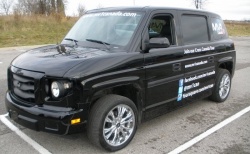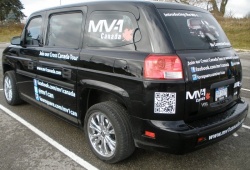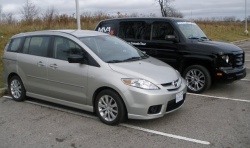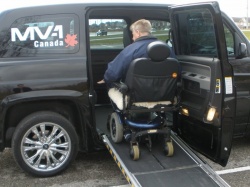 2012 MV-1. Click image to enlarge |
|
Manufacturer’s web site |
Review and photos by Brad Miller
Photo Gallery:
2012 MV-1
When it comes to vehicles for people living with limited mobility, mini-vans have been the preferred choice for many years. But with the introduction of the MV-1 (Mobility Vehicle 1), a first-of-its-kind, factory-built accessible vehicle, it looks like things are about to change. The MV-1 has been travelling across Canada since the beginning of the year, being promoted as “the first vehicle of its kind that has been factory built to meet the unique needs of people with disabilities and those who care for them.” So, here I am with the task of finding out if the MV-1 is really as good as they claim. To make my review fair, I asked a friend of mine, Gord, who uses a power wheel chair, to join me.
   2012 MV-1. Click image to enlarge |
The first thing you will notice about the MV-1 is its unique styling, which some say looks similar to a Honda Element on steroids. Once you get past the looks, you will realize that this vehicle was uniquely designed to handle the needs of people who use power wheel chairs or mobility scooters.
When you see the MV-1 in person for the first time you will be amazed by the size of this vehicle. It is much larger than your typical mini-van; smaller vans don’t even come close. The door openings are large and easily accessible, although we did notice that the area around the front driver and passenger doors felt a little cramped. Gord and I agreed that this probably won’t be a problem since many people will opt to exit the MV-1 through the very wide and tall side access door.
As with with many accessible vehicles, the power ramp is the most important feature. The designers of the MV-1 did a good job of making the ramp easy to use, thanks to the buttons, which are located within the side door. When using the power ramp, there are two setting choices: short or long. It’s a great feature as it allows you to adjust the ramp for specific situations. For example, when you are dropping off or picking up someone when parked next to a curb you can use the shorter setting. That’s very useful for those who live in more urban environments. One thing that really stood out to me and Gord was the fact that the designers decided to incorporate lighting into the side access door with the purpose of lighting up the ramp at night. That kind of detail really tells you the people behind the MV-1 took the time to focus on the safety and took into consideration the true needs of those who use and operate accessible vehicles on a daily basis.











